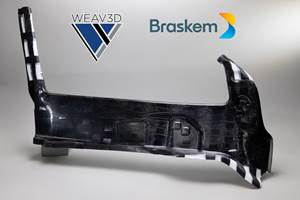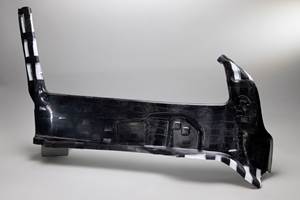PZTs energize active composites
NCC/ACI partnership to commercialize flexible lead zirconate titanate piezoelectric fibers in self-powered and "smart" composite products.
A large number of materials, man made and naturally occurring, possess polarity, meaning there is no center of symmetry in their crystal structures and therefore, the centers of positive and negative charges do not coincide. A number of polymers and ceramics, and even water, fit this description. Piezoelectric materials made from such ceramics have been available in monolithic form for many years. In simplest terms, piezoelectric materials can perform two desirable functions, 1) when subjected to mechanical stress, i.e., bent, compressed or flexed, they can generate an electrical charge, which then can be stored or used; 2) if an electric field is applied to the material, it can cause the material to deform, that is, change dimensionally. Piezoelectric devices are used in acoustic transducers, converting sound into electrical charges (e.g., in the receiver of a telephone) or to produce sound from electrical fields, such as in loudspeakers.
Advanced Cerametrics Inc. (ACI, Lambertville, N.J.) has developed a relatively low-cost manufacturing process for making piezoelectric ceramic materials into flexible fibers. These fibers are already used in high-profile sports equipment and, through the efforts of the National Composite Center (NCC), a Kettering, Ohio-based technology incubator, are moving into composites applications, especially in "smart" sensor and actuator applications. "When the National Composite Center was first introduced to Advanced Cerametrics flexible fiber," notes Lou Luedtke, NCC's president and CEO, "our staff saw an immediate fit for a nearly unlimited number of composite applications."
Although the process can be used to spin fibers from a great number of ceramic materials, the fiber with the most commercial success and potential for use in the composites industry, thus far, is lead zirconate titanate (PZT).
Conventional PZT materials are extremely rigid and typically produced in block form or as devices," Luedtke explains. "While the material could be incorporated into composites, its rigid characteristic made the material brittle and short-lived. ACI created the first flexible PZT ceramic fiber capable of harvesting energy, actively controlling structures or independently (without batteries) powering electronic systems in any application involving mechanical motion. ACI's PZT fiber also can function as a smart sensor, using the activity being sensed as its power source."
ACI's fibers can perform the same piezoelectric functions as monolithic PZTs, but at much reduced weight. ACI's Active Fiber Composite (AFC) actuators made with the fibers are about 35 percent lighter than conventional piezoelectric actuators.
Spinning a new fiber
ACI produces its PZT fibers in its Viscose Suspension Spinning Process (VSSP), on which ACI holds a patent. VSSP is a variation on the low-cost method used to produce rayon fibers. A ceramic powder in a water-based slurry is mixed with viscose, a thick liquid precursor of rayon fiber, composed of cellulose xanthate dissolved in a dilute aqueous solution of sodium hydroxide. The mix is extruded through a spinneret, an extrusion nozzle with hundreds or thousands of small-diameter holes (50 to 900 microns), into a special salt solution. An acid/base reaction then regenerates cellulose from the viscose material, and the salt dehydrates the fiber. The resulting "green" fiber is then sintered to create a fiber flexible enough to be handled like a textile (spooled, woven, etc.). The fiber can be processed like other fiber forms (glass, aramid, carbon) used in today's conventional processes.
Fibers can be produced with a variety of cross-sections (including tubular shapes) and with diameters that vary along their length at regular intervals, through alterations to the VSSP spin bath formulation. Fibers with variable diameters, a cooperative development of ACI and Yuntian Zhu of the Los Alamos National Lab (Los Alamos, N.M.), are of particular interest for use in composite materials, because the fibers would mechanically lock with a polymer matrix and thus resist pullout. Piezoelectric fibers have excellent fatigue resistance properties. ACI reports that lifecycle tests performed by the Fraunhofer Institute demonstrated that the materials could withstand 200 million operational cycles with no degradation in properties. The fibers range in size from 13 microns to 250 microns and can be laminated, potted or stack laminated. PZTs, however, cannot be used in place of conventional glass, carbon or aramid fibers in load-bearing structures.
Active, functional composites
ACI first incorporated its fiber technology in the newest generation of active, smart sporting goods. Head Sport AG's (Kennelbach, Austria) Intelligence line of "smart" tennis rackets uses the fibers to actively damp vibration. PZT fibers in the racquet frame generate low-current electricity that is transmitted to a coil in an electronic circuit housed within the racket's handle. The electric energy is stored, then released to flow back to the fibers in the racket, which deform in the optimal phase and waveform to counter-act the vibration. Active damping adds up to 15 percent more power to a ball hit and has been clinically proven to reduce tennis elbow. Head has sold more than 50,000 Intelligence rackets and more than 20,000 pairs of skis that use similar PZT damping technology to give alpine (downhill) skiers up to 10 percent greater control by reducing undesirable vibration, or "chatter." The material has also been incorporated into Head's Intelligence snowboard lines.
In addition to smart sporting goods, PZT fibers can be used in sonar, ultrasound, acoustic reproduction and medical equipment.
Scaling up for production
In collaboration with ACI, NCC submitted a proposal for the commer-cialization of the flexible PZT fibers for energy storage and smart systems and, in December 2004, received a State of Ohio, Third Frontier Wright Capital project award for $2.038 million (USD). In April this year, NCC signed a contract with the Findlay Hancock County Community Development Foundation (CDF), a division of the Findlay Hancock Chamber of Commerce in Findlay, Ohio, to establish the North Central Campus for Emerging Technology (NCC-ET). Housed in the Findlay Center for Business and Technology, the campus will be the site for scale-up of ACI's piezoelectric fiber composite production. Grant funds will be used to purchase the necessary equipment. NCC and ACI will begin work immediately to develop a high-volume, low-cost process for producing the piezoelectric fiber material for inclusion in composite parts.
According to NCC, the Findlay campus is intended as a strategic location from which ACI can link to the region's business, government and university resources and draw on its technical personnel. ACI and NCC will work together to incorporate PZT fibers and piezoelectric components into otherwise conventional composite laminates, but ACI also plans to use the campus to handle overflow production of the PZT actuators it produces for Head.
Development and commercialization activities at NCC-ET will focus on the aerospace and transportation industries. Applications for these markets will use the PZT fiber's capability to act as an energy harvester and "smart" sensor.
As an energy harvester, the PZT fiber will convert waste mechanical energy into electrical energy, creating a renewable energy source that eliminates the need for external power sources like batteries in many low power applications. PZT fibers will be incorporated into flexible, motion-sensitive composite shapes that could be placed in any location where there is a source of waste energy or mechanical deflection. Using microprocessor controls developed specifically for this purpose, the fiber captures the mechanical energy generated by a structure's vibration, compression or flexure and uses it to run low-power electronic systems. One application currently under development attaches the PZT fiber to the surface of a composite buoy. The fiber will capture mechanical energy from the motion of the buoy in the water and convert it to electrical energy to power the buoy's electro-luminescent lights. The lights would be readily visible, even through fog or smoke, from nearby watercraft.
As a smart sensor the PZT fiber is used to "sense" the health of a structure or perform "self-adjusting" or vibration damping functions. A smart structure that contains PZT fiber composite sensor/actuators takes advantage of the fiber's mechanical properties by first sensing a change in motion. This produces an electrical signal that is sent to a microprocessor control by a picoradio signal, using wireless tech-nology, such as Bluetooth. The microprocessor then measures the magnitude of the change, and relays a signal that either stiffens or relaxes the PZT fiber sensor/actuators, producing a self-adjusting or "smart" structure. Project applications for the transport-ation market could include self-adjusting automotive suspensions or self-diagnostic/self-curing bearings that use car vibrations as the source of power.
Vibration damping applications such as those pioneered by Head offer obvious advantages to composite manufacturers in automotive and aerospace markets. Such a smart sensor also has applications ranging from monitoring the health of aging aircraft to the health of humans using a person's pulse or physical activity as the power source. The power thus generated might be sufficient to replace the batteries in a pacemaker or an implanted chip medical record device.
"ACI's PZT ceramic fiber can be embedded into any type of composite material or attached to a structure's outside surface," Luedtke concludes. "The fiber's long life, ability to minimize or eliminate power consumption from traditional sources and minimize the damaging effects of vibration makes its uses in commercial applications nearly unlimited." Once production scale-up is complete, development of applications in new markets will be undertaken by ACI and NCC or by ACI in partnerships with other companies needing a versatile self-power capability.
Related Content
Braskem demonstrates PP solutions using Weav3D composite lattice technology
Partnership combines Braskem’s polypropylene sheets with Weav3D Rebar for Plastics technology to address new structural, automotive applications requiring high-strength, lightweight material solutions.
Read MorePEEK vs. PEKK vs. PAEK and continuous compression molding
Suppliers of thermoplastics and carbon fiber chime in regarding PEEK vs. PEKK, and now PAEK, as well as in-situ consolidation — the supply chain for thermoplastic tape composites continues to evolve.
Read More3D-woven composites find success in aerospace, space
CAMX 2024: Bally Ribbon Mills experts are displaying the company’s various joints, thermal protection system (TPS) technologies and other 3D woven composites for mission-critical applications.
Read MoreHighly tunable, woven lattice reinforcements target automotive structures
CAMX 2023: Startup Weav3D will be demonstrating its two collaborative automotive demonstrator parts and present two conference papers.
Read MoreRead Next
All-recycled, needle-punched nonwoven CFRP slashes carbon footprint of Formula 2 seat
Dallara and Tenowo collaborate to produce a race-ready Formula 2 seat using recycled carbon fiber, reducing CO2 emissions by 97.5% compared to virgin materials.
Read MoreDeveloping bonded composite repair for ships, offshore units
Bureau Veritas and industry partners issue guidelines and pave the way for certification via StrengthBond Offshore project.
Read MorePlant tour: Daher Shap’in TechCenter and composites production plant, Saint-Aignan-de-Grandlieu, France
Co-located R&D and production advance OOA thermosets, thermoplastics, welding, recycling and digital technologies for faster processing and certification of lighter, more sustainable composites.
Read More





















